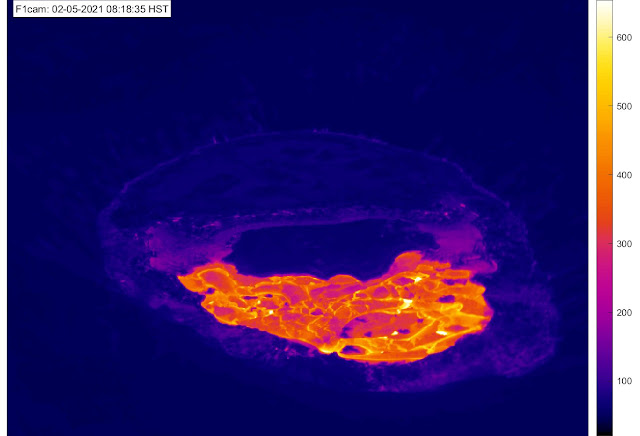Another morning of sun and birdsong. As it did yesterday, when weather is Kona, itʻs likely that billowing masses of cloud will form, rains will descend, and thunder may resound.
ʻUʻina pōhaku a Kāne, crackling rocks of Kāne [thunder]
We shall see in a few hours, but this morning, Kona winds waft puffs of ao māhu, clouds of mostly-steam, to the east as seen on the KEcam in the tower of the former HVO.
Pelehonuamea (Pele = the elemental, honua = matter or earth, mea = reddish) seems a bit diminished, though still very active, today.
Hereʻs another Thinking Out Loud moment (or two...)...I think Iʻve said in the past that pele (small "p") is lava. Hot. Cold. Lava. When one is typing away, isolated from others, the mind seems, sometimes, to lose expansiveness. We get stuck in a closed loop. Until. Until we visit with a long long time friend and kumu who reminds me: Pele and her pele are hot. Red. Molten. As in Pelehonuamea.
And then I wonder out loud, Well... what is pele that is cooled? Pāhoehoe or ʻaʻā? And kumu says (with a look saying I canʻt believe youʻre asking this) the generic term for rock or stone is: Pōhaku!
Talk about a DUH! moment! Of course. Of course. Specificities of description in English might be easy (sharp, smooth, ropy, spiny, billowy, rough, shiny, dull...) but theyʻre not so easy in ʻōlelo Hawaiʻi for those of us not fluent. But GoLook in The Dictionary:
LOTS of kinds of pōhaku. And though these are mostly utilitarian descriptions, wandering through the dictionary yields other pōhaku of varying colors and uses. And, as weʻve been taught, after the heat of Pele is gone, her sister Hiʻiaka assumes kuleana for revegetating and clothing the land with verdure.
That verdure includes plants we eat, including kalo ʻapuwai (ʻapu = cup, wai = fresh water).
ʻApuwai is a favorite because of its unique ruffled, cup-shaped lau (leaves). The water (dew or rain) captured in those cups is special, because it never touches the ground, and is collected for ritual uses.
Friends are blessed with a daughter, Kaʻapuwai, born yesterday in Hilo, and her name sent me on tangents. The ʻapuwai photos above were shared by her dad, and the description can be found in "Taro Varieties in Hawaiʻi", first published in 1939:
Taro Varieties in Hawaiʻi
Many are the subtleties and details... What a great fun way to train eyes to observe.
TryLook the video from HVO for February 3:
And lest we forget that Ke ao o Pelehonuamea (the realm of Pele) includes Maunaloa and other volcanoes, we leave with snowy Mokuʻāweoweo, closing this post, Number Two Hundred!
As always, with aloha,
BobbyC
maniniowali@gmail.com









No comments:
Post a Comment